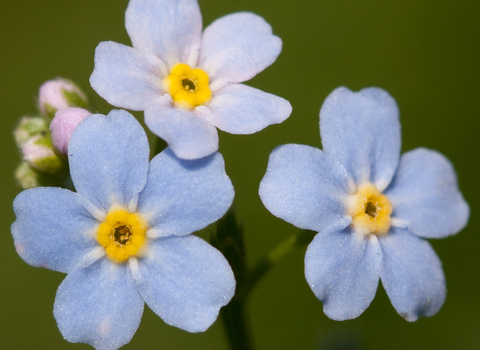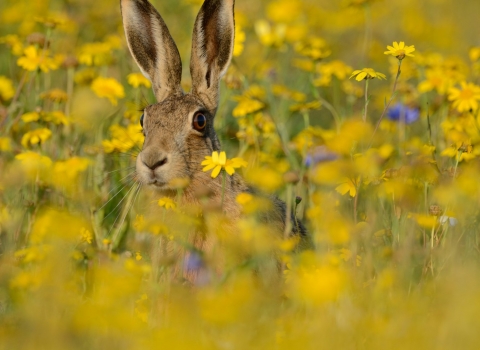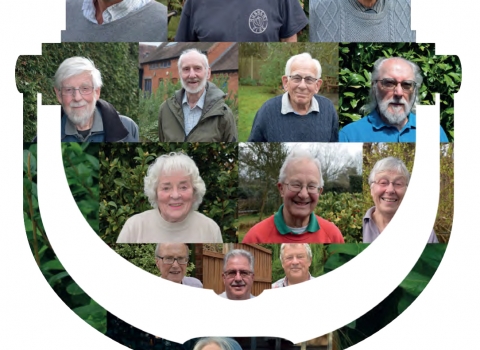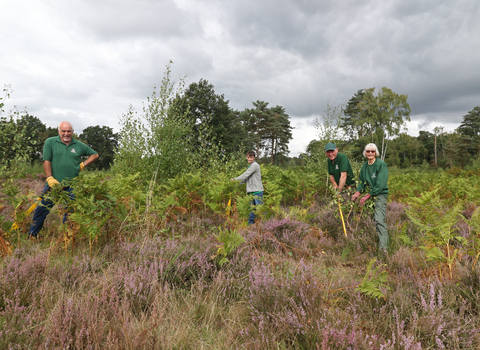The Trust has been built on the commitment and dedication of many people. Led by volunteers from the start (our first member of staff wasn't appointed until 1974), we owe much to their hard work and determination to help wildlife across Worcestershire.
Below, we pay tribute to some of those individuals that we have sadly lost in recent years and who we will remember for many years to come.
Michael Frederick Bretherton 1931-2024
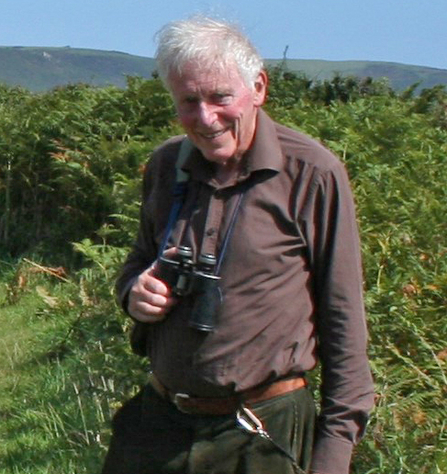
Mike Bretherton
Mike Bretherton, who passed away in June 2024 had a long and important association with Worcestershire Wildlife Trust for over 25 years as a volunteer, trustee and Honorary Secretary.
Having retired from a long career at Cadburys, Mike, who was a botany graduate and excellent naturalist, was able to fulfil a dream to “have his own nature reserve” as Reserve Manager of Feckenham Wylde Moor, a role he performed admirably for more than 20 years. He later took on the care of the Trust’s gardens at Lower Smite Farm, reflecting another of his great passions.
Mike also played a leading role in the Trust’s Bromsgrove Local Group and later became a trustee. He was able to apply a great breadth of knowledge and experience, encompassing ecology, finance and governance, that led him to serve as Honorary Secretary during the 1990s, when he played a major part in the modernisation of the Trust’s governance and management arrangements.
Mike stepped down from his Trust roles in 1998 and he and his wife, Pam, moved to Gloucestershire for a “proper” retirement where he indulged his other passion of our built heritage.
Mike’s legacy lives on through his two children Jez and Izzie, both of whom have pursued successful careers in the natural and built heritage sectors.
Colin Raven
Arthur Winspear Cundall 1929-2021
Arthur Cundall by Harry Green
Arthur Cundall died on 5th July 2021 aged 92 years. He had a lifelong interest in natural history, especially birds, and was closely associated with the West Midland Bird Club in the 1960s where he met like-minded people who, like him, were deeply interested in natural history and conservation. He became an excellent bird photographer, specialising in magnificent black and white prints often of birds at or near nests, and was a meticulous record keeper.
He belonged to the West Midlands Nature Conservation Trust, formed in 1958. When this broke up in 1968 to form county Trusts he transferred to Worcestershire Nature Conservation Trust (later Worcestershire Wildlife Trust) and soon became involved with its work, especially as warden of the Tunnel Hill nature reserve near Evesham. He tramped up the hill to the reserve thousands of times, carrying tools to cut back encroaching scrub and mow coarse vegetation in order to help conserve a remaining fragment of outstanding limestone grassland.
In the 1930s and 1940s the fringes of the River Avon and part of the River Severn were well-known as the main national breeding area of the nationally rare marsh warbler. Sites were bound in secrecy as marsh warblers were prime targets for egg collectors. A small group set out to study the warblers and to work for their conservation. Arthur supported this work, often spending many hours in a hide watching the activities of a breeding pair and keeping careful notes. Eventually all these studies led to understanding the birds’ habitat requirements and some of the Trust’s first reserves were set up to secretly protect marsh warblers. Unfortunately, the population withered and died out in the 1990s; just two to eight pairs remain in the UK.
Besides birds, Arthur was naturalist with wide interests and was often visiting the wilder parts of Bredon Hill with fellow naturalist, the late John Meiklejohn.
Later on he lost his job and undertook a variety of work to earn a living, amongst them supporting the Trust by mapping sites and detailed recording. He walked the newly established Wychavon Way and wrote a guide for Wychavon District Council.
Arthur continued to help look after the Tunnel Hill nature reserve into his eighties. For me, Arthur has always been there as a supporter of the Trust and a long-standing friend; I called on him the week before he died. The Trust has been built on the long-term dedication, hard work and support from quiet but determined people like Arthur Cundall. Long may his spirit wander amongst the flowers of Tunnel Hill.
Harry Green
John Richard Lashley 1946-2021

John Lashley by Wendy Carter
John Lashley, who passed away in May 2021, made a major contribution to the Trust in many ways. John’s friendly and approachable personality coupled with his sharp mind and extensive business expertise meant he collaborated in and contributed to many of the Trust’s activities over the last 20 years.
Before retirement John was instrumental in establishing a long-term relationship with Severn Waste Services who have subsequently contributed many hundreds of thousands of pounds towards the Trust’s work. Following retirement John was a founder member of the volunteer group who work on the farmland at Lower Smite Farm, the Trust’s headquarters, where conservation best practice is demonstrated. He subsequently applied his business acumen as an effective and valued trustee for several years and was also a member of the Board of the trading subsidiary W.N.C.T. Enterprises Limited, which operates the Trust’s commercial activities, including our Ecological Consultancy.
John’s extensive legacy for Worcestershire’s wildlife lives on through his daughter Becky, whose work for Worcestershire County Council’s Environment Team was recognised in her nomination as a Worcestershire Wildlife Hero in 2020.
Colin Raven
Dr Pam Gough 1924- 2019
Pamela Marjorie Gough, a great supporter of Worcestershire Wildlife Trust as well as Sussex Wildlife Trust and Wildlife Trusts Wales, died on 17th December, aged 95. Pam served on Worcestershire Wildlife Trust Council in the 1970s and 1980s where her background in education was useful. As a trustee Pam regarded it as her duty to visit all the Trust nature reserves and went on to investigate the history of several of them. She discovered that a Mr Eades had once farmed part of the wildflower meadow that the Trust acquired near Hanbury and so this grassland of national importance became Eades Meadow. In her research on Tiddesley Wood she discovered that it was common-land used for foraging pigs until 1223! Pam was delighted to be awarded the Trust’s Wild Service Award and proudly displayed the certificate in her living room.
Pam gained a BA in Geography with first class honours from London University and an M.A. in Ancient History and Archaeology from Birmingham University. In 1979 she was awarded a Ph.D. from Birmingham for fieldwork carried out in Wiltshire. She taught in schools until she joined the staff of Shenstone College in 1967 and remained there until the teacher training work ended. Although she was a reserved person who was happy with her own company, she was enthusiastic about leading many geography field courses all over the country and abroad. She also shared her interest by running an interesting Landscape History Group for the Bromsgrove U3A.
Sitting in her book-lined living room, Pam once surprised me by describing an adventurous journey she had made with a friend, travelling the length of Norway by car. She was a life-long member of the Geographical Society (later the Royal Geographical Society), and supported many other societies including the Worcestershire Naturalists and the Flower Society, undertaking flower surveys in Worcestershire for the latter.
The wonder of the countryside was of supreme importance to Pam and she requested that “All things bright and beautiful” should be sung at her funeral as it represented her religious views. Pam was buried at Westall Park Burial Cemetery on 14th January and a celebration and thanksgiving of her life followed at All Saints’ church, Bromsgrove, of which she was a highly respected member. She will be remembered as a person who loved the countryside and was passionate about understanding and sharing how the current landscape developed.
Tessa Carrick
Bert Reid 1943-2019
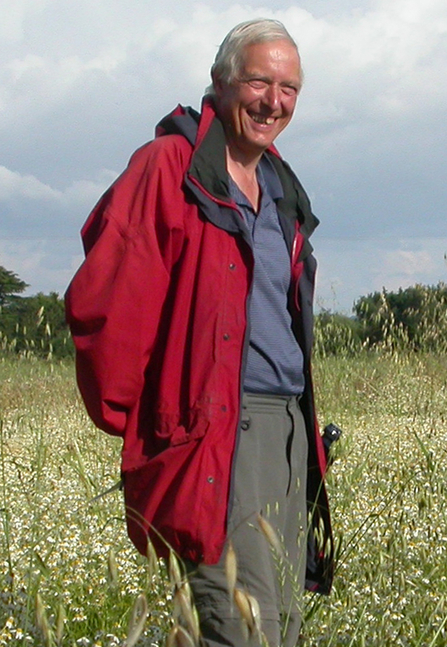
Bert Reid
One evening in September 1979, Worcestershire Nature Conservation Trust invited local members to a meeting in Evesham to help found the Southeast Worcestershire Local Group (SEWLAG). 120 members filled the hall and after presentations and wildlife films a tall smiling man came up to me and said quietly that he would like to help and, yes, he would join the committee and, yes, he would be treasurer. Bert Reid had entered the Trust and remained with us for 40 years. We soon discovered he was an excellent naturalist who went on to record hoverflies and plants in Tiddesley Wood as soon as it became a nature reserve in 1984.
Bert soon became a trustee and served many roles including Hon. Secretary and as Chairman. His quick brain and the ability to see through clutter to a good conclusion was a great asset to us; he was a great help to me during my own spell as Chairman. When Worcestershire Biological Records Centre (WBRC) came to the Trust he joined the steering group, serving on the governing board when it formed, and was an important part of the Worcestershire Recorders Committee.
As well as the above, he made a great contribution to Worcestershire’s natural history. He tramped through many miles of countryside recording plants, so playing a leading role in collecting data for the Worcestershire Flora project. He computerised the many thousands of records, prepared the maps for the book and wrote several of the introductory chapters. During this time he became fascinated by dandelions and their numerous micro-species and became a national expert in their identification. His contribution to the Worcestershire Flora on this complex group is outstanding.
Throughout all this, Bert remained true to SEWLAG, both on its committee and in practical activities, helping with the creation and growth of log sales and the open day at Tiddesley Wood.
Bert received two Worcestershire Wildlife Medals – one in his own right 2005 and the second with the small group that brought the Worcestershire Flora Project to a conclusion 2015. The medal is awarded “For dedicated service to nature conservation in Worcestershire”.
Sadly in the last few years he became increasingly ill. He died on 17th August 2019 aged 76 years. The Trust and Worcestershire natural history lost one of its greatest volunteer supporters and activists. Those of us who knew him for 40 years, especially in SEWLAG, lost a friend and companion who had been with us on the long journey working for nature conservation in Worcestershire.
Harry Green
John Meiklejohn 1926-2019
Every Worcestershire naturalist knew John. He was the man who could identify anything: plant, moss, lichen, beetle, spider, fish, snail, snake, bird or mammal. He was a patient and clear teacher, always willing to share and explain. Besides being a school teacher, he taught adult natural history classes for Birmingham University Extra Mural department for many years and inspired several generations of Worcestershire naturalists. He gave many talks and conducted many walks about natural history. His old hand-operated slide projector was famous even when the modern electronic world started to take over.
His passion was to accurately identify and record the natural world. When Worcestershire Biological Records Centre (WBRC) started in the 1970s he immediately became a leading light. He and a small group of naturalists kept it going through hard times until it was rescued by Worcestershire Wildlife Trust and re-started at their HQ at Lower Smite Farm. There the foundations were laid for today's WBRC by the hard voluntary efforts of John Meiklejohn and John Partridge. John even, reluctantly, learned how to use a computer, although he stuck to his beloved card index.
My first memories of him are from the 1960s when searching for rare marsh warblers near his house in Defford. A little later he provided accommodation and support for several researchers; one of them caught a large green beetle in nets set to catch birds for ringing and release. John identified it as the rare noble chafer – the first to be found in this part of Worcestershire, much to amazement of national experts. In many cases he recorded firsts for Worcestershire (I often took him insects to identify and in later years this often involved a trial of his latest home-made wine and many stories of his youth on a farm, his wartime travels round the world and, later, European travels with his young family.
John was awarded the Worcestershire Wildlife Medal in 2001 and part of the citation read “John's influence on wildlife conservation is greater than might be immediately apparent. His great contribution has been to raise awareness in the wonders of natural history in many people through his enthusiasm, helpfulness, and inspirational teaching. He is no elitist or parader of knowledge. He will talk to and teach anyone. Never is it too much trouble to look at any specimen, to identify it and inform the finder. He is undoubtedly Worcestershire's leading naturalist.”
For Worcestershire’s natural history John made a real difference, he taught many people, recorded many things, and was a great friend.
John died on 4th July 2019 aged 93.
Harry Green

